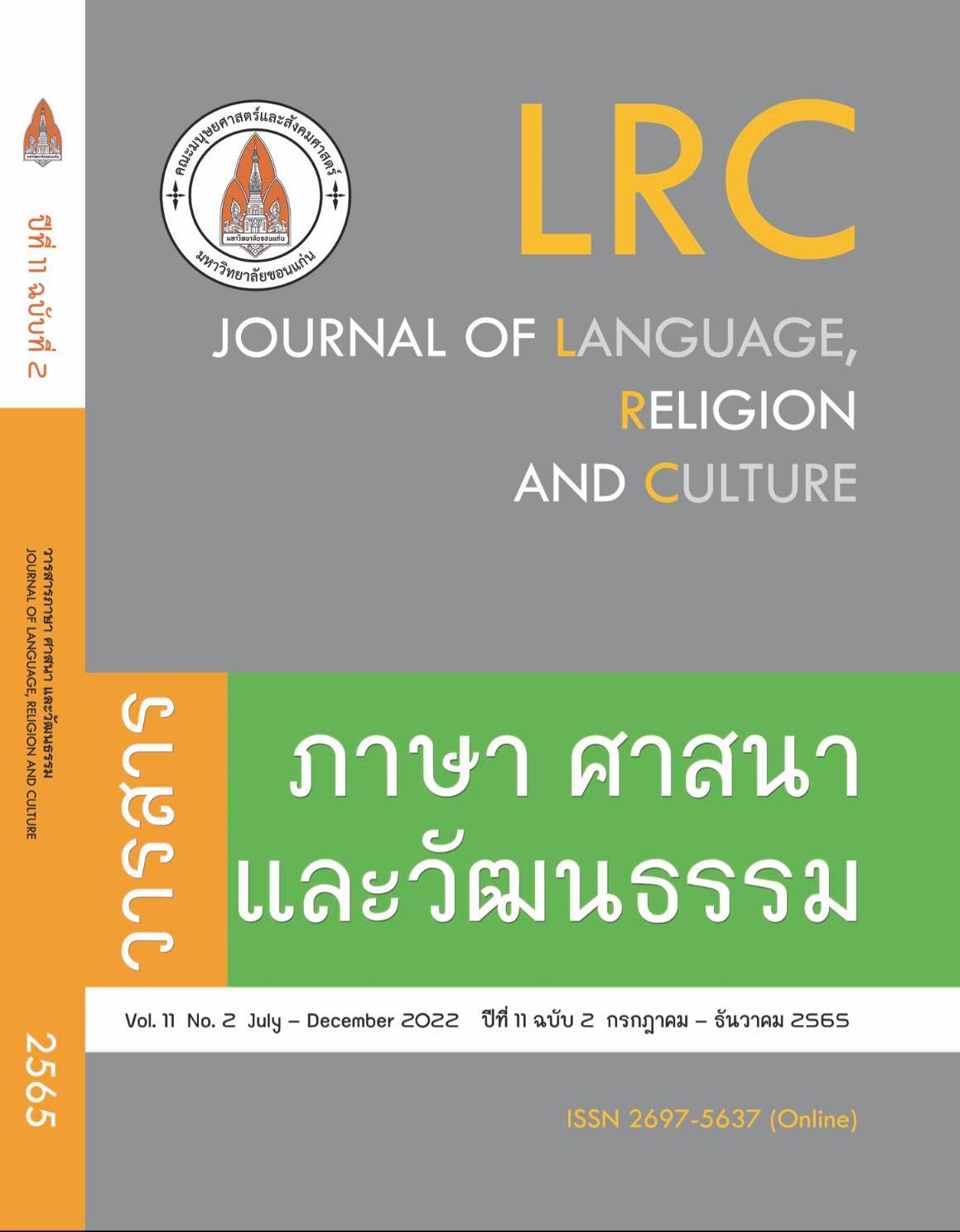อิทธิพลของชนิดในการใช้คำอุปลักษณ์ บริบท และวัฒนธรรมที่ส่งผลต่อการตีความของผู้เรียน
อิทธิพลของชนิดในการใช้คำอุปลักษณ์ บริบท และวัฒนธรรมที่ส่งผลต่อการตีความของผู้เรียน
คำสำคัญ:
คำอุปลักษณ์, การตีความ, การวางตำแหน่งคำอุปลักษณ์ , ชนิดของคำอุปลักษณ์ , อิทธิพลทางวัฒนธรรมบทคัดย่อ
แม้ว่าคำอุปลักษณ์ จะไม่ได้ปรากฏอย่างชัดเจนในโครงสร้างทางภาษา แต่ก็ใช้เพื่อสื่อข้อความของผู้พูด นอกจากนี้ เห็นได้ชัดว่าการตีความคำอุปลักษณ์ขึ้นอยู่กับความรู้ความเข้าใจ และภูมิหลังทางวัฒนธรรมที่คำอุปลักษณ์ได้รับการพัฒนามา ดังนั้น งานวิจัยนี้จึงมีวัตถุประสงค์เพื่อศึกษาอิทธิพลของประเภทของคำอุปลักษณ์ บริบท และวัฒนธรรมที่มีผลต่อการตีความเชิงเปรียบเทียบของผู้เรียนที่ใช้ภาษาอังกฤษเป็นภาษาต่างประเทศ โดยใช้วิธีการเก็บข้อมูลผ่านแบบทดสอบการแปลและเทคนิคการคิดแบบออกเสียง โดยคัดเลือกผู้เรียนแบบเจาะจง จำนวน 20 คน ให้แปลสำนวนเปรียบเทียบ 9 รายการ และรวบรวมข้อมูลชนิดของคำอุปลักษณ์ บริบทและอิทธิพลทางวัฒนธรรมที่มีผลต่อการตีความผ่านการสัมภาษณ์ขณะแปลงาน ความถูกต้องของการตีความและปัจจัยอื่นที่เกี่ยวข้องถูกนำมาวิเคราะห์จากค่าเฉลี่ยและส่วนเบี่ยงเบนมาตรฐานโดยใช้ ANOVA ผลการวิจัย แสดงให้เห็นว่า ความรู้ บริบท และภูมิหลังทางวัฒนธรรม รวมถึงประเภทของคำอุปลักษณ์ส่งผลต่อการตีความของผู้เรียน ผู้เรียนชาวไทยมักจะตีความคำอุปลักษณ์เชิงสัมพันธ์ (relational metaphor) ได้ถูกต้องมากกว่าคำอุปลักษณ์เชิงกายภาพ (attributional metaphor) และคำอุปลักษณ์เชิงซ้อน (double metaphor) นอกจากนี้ พวกเขายังมีแนวโน้มที่จะตีความคำอุปลักษณ์ซึ่งวางไว้ที่ส่วนต้นและส่วนกลางของข้อความได้ดีกว่าคำอุปลักษณ์ซึ่งวางไว้ที่ส่วนท้ายของข้อความ โดยสรุปแล้วจากการศึกษาพบว่าการตีความคำอุปลักษณ์มีความสำคัญต่อการเรียนภาษาอังกฤษ นอกจากนี้บทเรียนดังกล่าวสามารถปรับปรุงบรรยากาศในห้องเรียนและยังเสริมสร้างแรงบันดาลใจต่อการเรียนภาษาอังกฤษอีกด้วย การเพิกเฉยต่อบทเรียนเกี่ยวกับคำอุปลักษณ์ยังสามารถส่งผลต่อผลคะแนนในการทดสอบหรือการสอบวัดความรู้ทางภาษาได้
เอกสารอ้างอิง
Banaruee, H., Khoshsima, H., Zare-Behtash, E., & Yarahmadzehi, N. (2019). Types of metaphors and mechanisms of comprehension. COGENT EDUCATION, 6(1).
Dancygier, B., & Sweetser, E. (2014). Cambridge textbooks in linguistics. Figurative
language. New York, NY, US: Cambridge University Press.
Foss, D., & Lynch, R. (1969). Decision processes during sentence comprehension: Effects
of surface structure on decision times. Perception & Psychophysics, 5(3), 145-148.
Gentner, D. (1988). Structure-Mapping: A Theoretical Framework for Analogy. Readings in
Cognitive Science, 303-310.
Gentner, D., Bowdle, B., Wolff, P., & Boronat, C. (2001). Metaphor is like analogy. The
analogical mind: Perspectives from cognitive science, 199-253
Gibbs Jr., R., & Gerrig, R. (1989). How Context Makes Metaphor Comprehension Seem
Special. Metaphor and Symbolic Activity, 4(3), 145-158.
Inhoff, A., Lima, S., & Carroll, P. (1984). Contextual effects on metaphor
comprehension in reading. Memory & Cognition, 12(6), 558-567.
Jayaram, M. (1984). Distribution of stuttering in sentences: relationship to sentence length
and clause position. Journal of Speech, Language, and Hearing Research, 27(3), 338-341.
Kökcü, Ş. (2017). Turkish EFL learners’ interpretation of metaphors: A study on conceptual
socialization (Doctoral dissertation, Bilkent University).
Kömür, S. & Çimen, S (2009). Using conceptual metaphors in teaching idioms in L2 context.
Muğla Üniversitesi Sosyal Bilimler Enstitüsü Dergisi (İLKE) Güz, 205-221.
Lakoff, G., & Johnson, M. (1980). The metaphorical structure of the human conceptual
system. Cognitive Science, 4(2), 195-208.
Lakoff, G., & Johnson, M. (2008). Metaphors we live by:. Chicago, Ill: The University of
Chicago Press.
Lewis, C. (1982). Using the 'thinking-aloud' method in cognitive interface design. Research
Report RC9265, IBM TJ Watson Research Center.
Littlemore, J. (2003). The effect of cultural background on metaphor interpretation. Metaphor and symbol, 18(4), 273-288.
Manowong, S. (2011). The study of ability to interpret conversational implicatures in
English of Thai EFL learners. The Asian Conference on Language Learning
Official Conference Proceedings 2011. 138-148. The International Academic
Forum, Osaka, Japan.
Newmark, P. (2009). A textbook of translation. Shang hai: Shang hai wai yu jiao yu chu ban she.
Saeed, J. I. (1997). Semantics. Cambridge: Blackwell.
Shen, L. (2020). Discussion on the application of metaphor in English culture teaching. Proceedings of the 2020 Conference on Education, Language and Inter-Cultural Communication (ELIC 2020).
Shokouhi, H., & Isazadeh, M. (2009). The Effect of Teaching Conceptual and Image ¬Metaphors to EFL Learners. The Open Applied Linguistics Journal, 2(1), 22-31.
Tayjasanant, C. (2012). Thai university students’ understanding and perception of English metaphors in news articles. The International Journal of the Humanities: Annual Review, 9(10), 129–146.
Tonini, E., Lecce, S., Del Sette, P., Bianco, F., Canal, P., & Bambini, V. (2022). Efficacy and benefits of the Metacom training to promote metaphor comprehension in typical development. First Language, 42(3), 466–496.
Trompenaars, F. (1993). Riding the waves of culture. Understanding cultural diversity in
business. London: Nicholas Brealey Publishing.
ดาวน์โหลด
เผยแพร่แล้ว
รูปแบบการอ้างอิง
ฉบับ
ประเภทบทความ
สัญญาอนุญาต
ลิขสิทธิ์ (c) 2022 วารสารภาษา ศาสนา และวัฒนธรรม

อนุญาตภายใต้เงื่อนไข Creative Commons Attribution-NonCommercial-NoDerivatives 4.0 International License.







